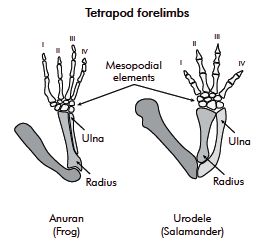Journal of Creation 26(2):10, August 2012
Browse our latest digital issue Subscribe
Problems with the evolutionary interpretation of limb design

To evolutionists, the vertebrate forelimbs are a classic example of homology.1 Their similarities are regarded as undeniable evidence of descent with modification, and they appear in almost every educational textbook promoting evolution. Counter-arguments presented by creationists include the observation that digit development can be different in amniotes and amphibians2 (e.g. humans and frogs) and that the forelimbs grow from different embryonic segments (somites) in different species (e.g. newt, lizard and man).3,4 If descent with modification were the correct explanation for common forelimb design, we would expect the forelimbs to develop in similar ways and from the same parts of the embryo.
A less well-known problem for evolutionists is the unique order of limb bone development seen in urodeles, something that has been clarified recently by Fröbisch and Shubin.5 Generally, tetrapods (including anurans) show a distinct postaxial dominance in their pattern of limb skeletogenesis, meaning that the outer bones form before the inner bones. For example, the ulna leads the radius and the digits develop in the sequence IV-III-II-I. Salamanders, however, show a preaxial dominance, with the inner bones forming before the outer bones, for example, the radius leading the ulna, and digits I and II forming before III and IV. Also, whereas in most tetrapods the proximal mesopodial elements form before the distal ones (i.e. in a direction from tail to head), in salamanders this is reversed.

As argued by ReMine,6 the natural world appears to have been designed so as to point to a general unity and thus a single creator, yet with exceptions that resist evolutionary explanations. All organisms use DNA but a few utilize a different DNA code, thus ruling out common ancestry.7 (To change from one code to another would require the absurdly improbable event of a simultaneous modification of both the DNA and its translation apparatus.) Similarly, vertebrate forelimbs show a common design, but develop in different ways, supporting the view that the different vertebrate kinds were independently created. If these two amphibian groups had really arisen from a common ancestor, the embryological pathways would not be expected to show such divergent characteristics.
References
- Homology refers to similarity in structure, which, according to the theory of evolution, is due to common ancestry. Return to text.
- Futuyma, D., Evolutionary Biology, Sinauer Associates, Sunderland, MA, 2nd ed., p. 436, 1986. Return to text.
- De Beer, G., Homology: an Unsolved Problem, Oxford University Press, UK, 1971. Return to text.
- Kofahl, R.E., A serious problem for homology, Creation 14(2):31, March 1992; creation.com/a-serious-problem-for-homology. Return to text.
- Fröbisch, N.B. and Shubin, N.H., Salamander limb development: Integrating genes, morphology, and fossils, Developmental Dynamics 240:1087–1099, 2011; onlinelibrary.wiley.com. Return to text.
- ReMine, W.J., The Biotic Message, St Paul Science, St Paul, MN, 1993. Return to text.
- Two examples of organisms with unusual genetic codes are the yeast Candida tropicalis and the ciliate Paramecium. Return to text.





Readers’ comments
Comments are automatically closed 14 days after publication.